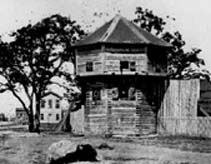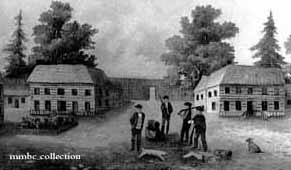INFORMATION
Tour Home
Contact Us
Copyright © 2000
History of Racialisation Group
Victoria, BC CANADA
All rights reserved
This page last updated
17 July 2000
Contact the Page Maintainer
Hosted by
the University of Victoria

This site looks best with
![]()
Imperial Paradise?
An Alternative Walking Tour of Victoria, BC
![]() Bastion Square
Bastion Square ![]()

The Fort's Bastion, c.1870s
The HBC fort, as depicted by a contemporary artist.
The Bastion is symbolic of the threat of violence that always lay in the background of aboriginal – immigrant relations. Generally speaking, the HBC stayed on good terms with the local people, but when there were disagreements the gun ports of the Bastion were opened and the cannons were used to show that the HBC would ultimately have things their way.
When Great Britain decided to appropriate the land as a colony in 1849, they chose Victoria as the capital. In the shadow of the bastion, within the walls of the fort, the first colonial assembly was held and the first of the British laws were passed.
